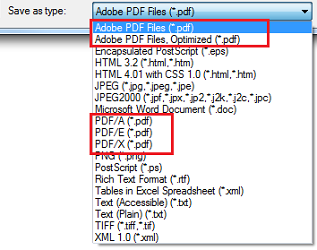PDF STANDARDS
PDF STANDARDS
There are a total of eight PDF standards; six are ISO Standards and two are from other organizations.
SIX TYPES OF PDF STANDARDS FROM ISO
ISO stands for International Standards Organization, which issues certifications for products that meet their standards across many industries, PDF documents included. They set standards, based on a rigorous certification process, to assure quality, reliability and universality. Each PDF standard from ISO has guaranteed quality which was based on a specific set of circumstances. So, which standard you use will be determined by your set of document circumstances – how your PDF will be stored, viewed, shared, printed, etc.
 PDF –This general PDF standard is sufficient for in-office use, sharing and viewing online and for standard quality documents.
PDF –This general PDF standard is sufficient for in-office use, sharing and viewing online and for standard quality documents.- PDF/A – This standard was developed for long-term file storage, commonly used by archivists, records managers and compliance managers. It has a restricted set of features, including JavaScript, audio and video content and encryption, because they may disallow users from opening and viewing accurately in the future.
- PDF/E – Architects, engineers, construction professionals and manufacturing product teams will use this standard most often. According to Planet PDF, “This standard was intended to address key issues in the areas of large-format drawings, multimedia, form fields and rights management – to name a few – that might prevent the engineering community from embracing PDF in their workflows.”
- PDF/X – This standard best suits print professionals, graphic designers and creative professionals. High quality, professional grade documents can be expected when using this standard. This PDF standard will ensure documents are print-ready by correctly embedding fonts, images, color profiles and more.
- PDF/UA – This standard enhances the readability for people with disabilities, IT managers in government or commercial enterprises and compliance managers. The UA stands for Universal Access; this standard will work with assistive technology that assists users through reading and navigation.
- PDF/VT – Print professionals will also use this standard for documents. This standard is based on components of the PDF/X standard, allowing some features such as color profiles, layers and transparency to be maintained. The biggest addition is the ability to customize data within these files, such as bank statements, business invoices or personalized marketing material.
TWO TYPES OF PDF STANDARDS FROM OTHER ORGANIZATIONS
Additional organizations have adopted standards for their specific document needs.
- PAdES – Standardizes secure paperless transactions that conform to the European legislation. This standard was established for PDF digital signatures in the EU.
- PDF Healthcare – According to Acrobat, This standard “Provides best practices and implementation guidelines to facilitate the capture, exchange, preservation and protection of healthcare information. Following these guidelines provides a more secure electronic container that can store and transmit health information including personal documents, XML data, DICOM images and data, clinical notes, lab reports, electronic forms, scanned images, photographs, digital X-rays and ECGs.”
Knowing your PDF options will optimize your document quality if you have specific document viewing, sharing, printing or archiving purposes. If you would like more information about printing high quality PDFs (PDF/X), check back soon for our PDF presets article.